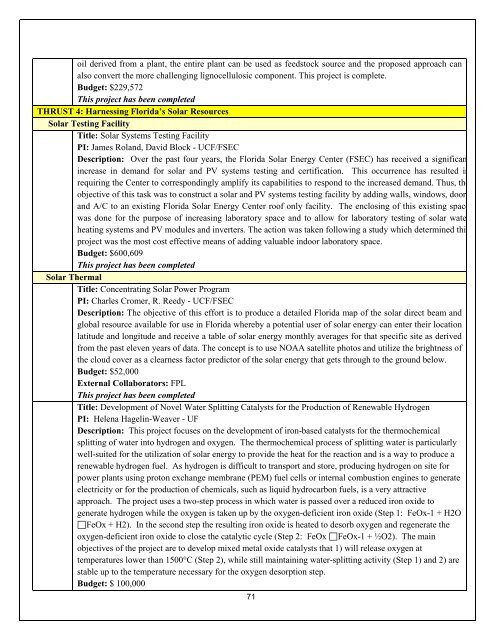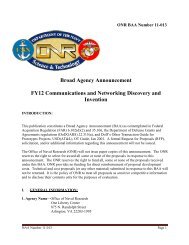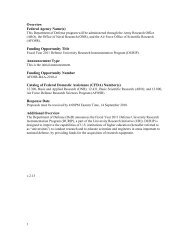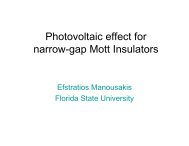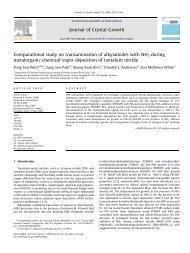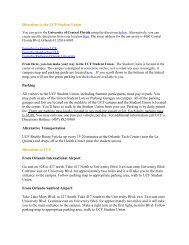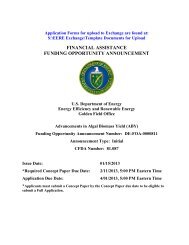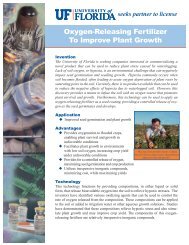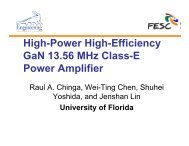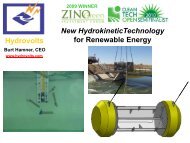Annual Report- Part III - Florida Energy Systems Consortium
Annual Report- Part III - Florida Energy Systems Consortium
Annual Report- Part III - Florida Energy Systems Consortium
Create successful ePaper yourself
Turn your PDF publications into a flip-book with our unique Google optimized e-Paper software.
oil derived from a plant, the entire plant can be used as feedstock source and the proposed approach canalso convert the more challenging lignocellulosic component. This project is complete.Budget: $229,572This project has been completedTHRUST 4: Harnessing <strong>Florida</strong>’s Solar ResourcesSolar Testing FacilityTitle: Solar <strong>Systems</strong> Testing FacilityPI: James Roland, David Block - UCF/FSECDescription: Over the past four years, the <strong>Florida</strong> Solar <strong>Energy</strong> Center (FSEC) has received a significanincrease in demand for solar and PV systems testing and certification. This occurrence has resulted inrequiring the Center to correspondingly amplify its capabilities to respond to the increased demand. Thus, theobjective of this task was to construct a solar and PV systems testing facility by adding walls, windows, doorand A/C to an existing <strong>Florida</strong> Solar <strong>Energy</strong> Center roof only facility. The enclosing of this existing spacewas done for the purpose of increasing laboratory space and to allow for laboratory testing of solar wateheating systems and PV modules and inverters. The action was taken following a study which determined thiproject was the most cost effective means of adding valuable indoor laboratory space.Budget: $600,609This project has been completedSolar ThermalTitle: Concentrating Solar Power ProgramPI: Charles Cromer, R. Reedy - UCF/FSECDescription: The objective of this effort is to produce a detailed <strong>Florida</strong> map of the solar direct beam andglobal resource available for use in <strong>Florida</strong> whereby a potential user of solar energy can enter their locationlatitude and longitude and receive a table of solar energy monthly averages for that specific site as derivedfrom the past eleven years of data. The concept is to use NOAA satellite photos and utilize the brightness ofthe cloud cover as a clearness factor predictor of the solar energy that gets through to the ground below.Budget: $52,000External Collaborators: FPLThis project has been completedTitle: Development of Novel Water Splitting Catalysts for the Production of Renewable HydrogenPI: Helena Hagelin-Weaver - UFDescription: This project focuses on the development of iron-based catalysts for the thermochemicalsplitting of water into hydrogen and oxygen. The thermochemical process of splitting water is particularlywell-suited for the utilization of solar energy to provide the heat for the reaction and is a way to produce arenewable hydrogen fuel. As hydrogen is difficult to transport and store, producing hydrogen on site forpower plants using proton exchange membrane (PEM) fuel cells or internal combustion engines to generateelectricity or for the production of chemicals, such as liquid hydrocarbon fuels, is a very attractiveapproach. The project uses a two-step process in which water is passed over a reduced iron oxide togenerate hydrogen while the oxygen is taken up by the oxygen-deficient iron oxide (Step 1: FeOx-1 + H2O FeOx + H2). In the second step the resulting iron oxide is heated to desorb oxygen and regenerate theoxygen-deficient iron oxide to close the catalytic cycle (Step 2: FeOx FeOx-1 + ½O2). The mainobjectives of the project are to develop mixed metal oxide catalysts that 1) will release oxygen attemperatures lower than 1500°C (Step 2), while still maintaining water-splitting activity (Step 1) and 2) arestable up to the temperature necessary for the oxygen desorption step.Budget: $ 100,00071


